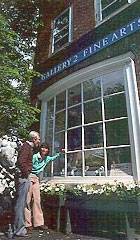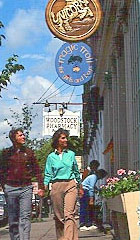Attractions ~ Exploring Hawk Country ~ Woodstock, Vermont
Located only 20 minutes northeast of Hawk, Woodstock is noted for its natural and man-made beauty, cradled, as it is, between leafy green hills and the serpentine Ottauquechee River. It is most popular among shoppers and nature enthusiasts, being home to over 35 retail stores, art galleries and antique shops, all within walking distance of each other, and host to the renowned Billings Farm & Museum and the Northeast's only Raptor Center, devoted exclusively to birds of prey. The award-winning 18-hole championship Woodstock Golf Course is also highly sought-after among sports enthusiasts. In between activities, Woodstock's eateries run the gamut from cafes to gourmet restaurants, and provide the perfect respite to an afternoon of heavy-duty shopping.
 |
Woodstock has thoughtfully preserved its architectural and natural heritage; much of the village is included in a Historic District. Because of its superior schools, many community services and a range of recreational facilities, the population has swelled to over 3500 people. However, Woodstock remains a quaint yet cosmopolitan historic village that epitomizes the towns of central Vermont. With its rural valley setting, main and residential streets, homes and community buildings nestled around the Green, as well as unobstructed views to adjacent fields, wooded hillsides and undeveloped ridgetops, the village captures the very essence of the Vermont townscape.
Noteworthy Attractions in and Around Woodstock
Billings Farm & Museum, Woodstock
Celebrating Vermont's heritage of rural farm life, Billings Farm is a particularly special treat - a thriving museum of rural Vermont, as well as a working dairy farm. The working farm is active with purebred Jersey cows, known for their rich milk, Southdown sheep and draft horses to help in the field. Step back in time in the 1890 Farm House, carefully restored to its 19th-century heyday when it served as the hub of the farm and forestry operation, and explore the galleries devoted to turn-of-the-century Vermont family farm living. Established in 1871, Billings Farm remains one of the country's premier agricultural museums. Here, the legacy of responsible agriculture and land stewardship that was established more than a century ago continues both in practice and in spirit... Open May through October. (802) 457-2355
Vermont Institute of Natural Science and Raptor Center, Woodstock
Vermont's premier raptor rehabilitation center and the only museum in the Northeast devoted to birds of prey, this outdoor museum houses injured birds of prey such as snowy owls, red-tailed hawks, peregrine falcons and bald eagles in spacious, naturalistic habitats. Take a guided tour or find your own wildlife along the self-guided trails of the Center's 78-acre nature preserve. Open year-round. (802) 457-2779
 |
Marsh-Billings-Rockefeller National Historical Park, Woodstock
The first national park to focus on the theme of conservation history and the evolution of land stewardship in America, Marsh-Billings-Rockefeller National Historical Park is a gift to the people of the United States from Laurance S. and Mary F. Rockefeller. Encompassing the historic Marsh-Billings-Rockefeller Farm and Estate, the park actually represents several generations of conservationist thought and practice. Frederick Billings, the grandfather of Mary French Rockefeller, created the estate in the late nineteenth century when he established a progressive dairy farm and a professionally managed forest. In these efforts, Billings had been influenced by writer, statesman and conservationist George Perkins Marsh, who earlier had grown-up on the property. In his 1864 book, Man and Nature, Marsh described the spreading ecological destruction of America's countryside and argued for a new ethic of responsible stewardship. Today, the park, encompassing the original mansion, gardens and the surrounding Mount Tom Historic Forest, stands as a cultural landscape of great historic significance and integrity. Open May through October. (802) 457-3368
Sugarbush Farm, Woodstock
This picturesque, family-run working farm set on a hilltop outside of town is famous for its excellent Vermont cheese and pure maple syrup made on the premises. Features a quiet, woodland Farm Chapel and a nature trail that follows the same path used by the draft horses to bring maple syrup back to the sugarhouse in the springtime. (802) 457-1757
Woodstock Historical Society, Woodstock
Located in the 1807 Charles Dana House, this museum has an extensive collection of 18th- and 19th-century furnishings. Exhibitions include decorative arts, portraits, antique toys, dolls, historic costumes, household and artisan tools, sleighs and Woodstock-area artifacts. Also contains a 12,000-volume research library and archives. Open May though October (and weekends in December). (802) 457-1822
Pentangle Council on the Arts, Woodstock
The 400-seat, historic Woodstock Town Hall Theater, renovated in 1988, hosts artists from around the world in the Pentangle's main state series year-round, and in the Down by the River picnic concert series on the banks of the Ottauquechee, the Maybe Mozart chamber music concerts, and the noontime Brown Bag concerts each summer. The intimate Little Theater, a 150-seat performance space, located in an old mill building on the Ottauquechee River is host to the Pentangle's Coffee House Concerts and to the Woolhouse Players, a community theater company. (802) 457-3981
Norman Williams Public Library, Woodstock
Periodical, children's and general reading rooms contain original Woodstock imprints and town files for the serious historical buff. Open year-round except Sunday. (802) 457-2295
Academy Historical Association, South Woodstock
A schoolhouse and furnishings of the mid-nineteenth century preserved at Green Mountain Perkins Academy illustrate the history of the Woodstock region. Open July & August. (802) 457-1141
The Old Mill Marketplace, Bridgewater
A rambling three-story shopping center and living museum overlooking the Ottauquechee River. Regional items and specialties are located in the Vermont Sampler section. Other offerings include the Sun of the Heart Bookstore and both the largest craft center and the largest ski and snowboard warehouse in Vermont. On the top floor, the Bridgewater Mill Antique Center represents over 150 dealers in 8,000 square feet of space. This famous woolen mill, one of the oldest commercial structures in Vermont, is listed on the National Registry of Historic Buildings. (802) 672-3332
A Brief History
The town of Woodstock was settled over 200 years ago by hardy, self-reliant farmers, preachers, millers and merchants. Later, doctors, teachers and lawyers, drawn to the Shire Town and County Court, brought about greater wealth and sophistication, and the Village Green soon became the magnificent showcase of the beautiful Federal and Colonial homes that it remains today. The question most frequently asked about Woodstock is, "How does one account for the many fine homes when there is no evidence of industry to support them?" The answer is that a bare 20 years after the first settler arrived in 1765, Woodstock became the Shire Town (or seat) of Windsor County. Business and professional people were drawn to the town, and coming largely from Connecticut and Massachusetts, they brought an established culture with them. Families were large, materials cheap and plentiful and the earliest houses, many of which survive today, were well and amply built.
Virtually everything had to be grown or made locally, and nearly every house included a business or trade as well, for barter was easier than trading for money. More than twenty shops and industries flourished just around the Green: flat silver, saddlery and pearlash were made; a hatter, a tailor, smithy, baker, two printers, a jeweler and cabinetmaker each hung their shingles while a tannery and currying business, a tinshop, two schools, two hotels and a courthouse completed the circuit. All this was in addition to the more formal shops on Elm, Pleasant and Central Streets.
The streams and outlying districts burgeoned with lumber, saw mills and gristmills, carding, woolen and fulling mills, linseed oil and cider-pressing mills, a gin distillery, clothier and dye house, brick kiln and iron casting furnace. Pottery, copperage, basketry and woodenware were made; a clockmaker, wheelwright, bookbinder and carriage-maker plied their trades; a comb factory, machine and tool shops existed, and the manufacture of musical instruments ranged from flutes, bass viols and drums to pianos. Five weekly newspapers were once published contemporaneously and all while agriculture, wood processing (potash, prepared by leaching wood ashes to form lye used in making soap and glass, and pearlash, a more refined form) and animal husbandry flourished. Justin Morgan, progenitor of the Morgan, earliest American breed of horse, was stabled in Woodstock for a time in 1802. For years, Windsor County was the United States center of the Jersey cow. The Merino sheep was first introduced into the country at Weathersfield Bow, just south of Woodstock, and flourished for 75 years.
The population peak passed in the mid-nineteenth century and, as the rest of the world's goods became more accessible (a railroad served the town for 58 years), Woodstock became less and less industrial. Its popularity as both a summer and winter resort dates back into the last century, but the town and the world were never quite the same after that January weekend in 1934 when man first road a rope tow up a ski hill in Farmer Gilbert's pasture at the north end of town. The country's first Poma lift supplanted the rope tow locally in 1954 on the 20th anniversary of its creation. Today, Suicide Six ski area stands on the same spot just outside of town.
Among Woodstock's notable citizens were Hiram Powers, sculptor of The Greek Slave, and Senator Jacob Collamer, confidant of President Lincoln. It was he who coined the phrase: "The good people of Woodstock have less incentive than others to yearn for heaven." Another eminent figure was John Cotton Dana, the well-known librarian and museum director, who first opened the restricted book stacks to the public. More recent residents include actor Otis Skinner and noted author Sinclair Lewis.
Much of Woodstock's historic and environmental preservation can be traced to the dedicated efforts of George Perkins Marsh, Frederick Billings and Laurance S. Rockefeller. Marsh, the 19th-century congressman largely responsible for the establishment of the Smithsonian Institute, was the author of the ecologists' bible Man and Nature. Billings, builder of the Northern Pacific Railroad, purchased the Marsh homestead and reforested Mt. Tom and Mt. Peg. The Marsh-Billings Mansion is now occupied by Billings' granddaughter, Mary Rockefeller, and her husband, who have perpetuated the tradition of environmental conservation and the appropriately-scaled commerce which underlies Woodstock's economic vitality and quality of life. In 1998, their home and the surrounding woodlands became, under the ownership of the National Park Service, the Marsh-Billings National Historical Park, paying tribute to both Woodstock's and the nation's conservation efforts and traditions.
See Also
Hawk's Guide to Vermont Shopping and check-out some of the wonderful shops in Woodstock and the surrounding towns.
Plymouth / Calvin Coolidge Homestead (Our hometown...)
Ludlow / Okemo (10 minutes)
The Killington Region (10 minutes)
Weston (25 minutes)
Rutland (30 minutes)
Quechee (35 minutes)
Manchester (45 minutes)
Back to Exploring Hawk Country
Back to top
|